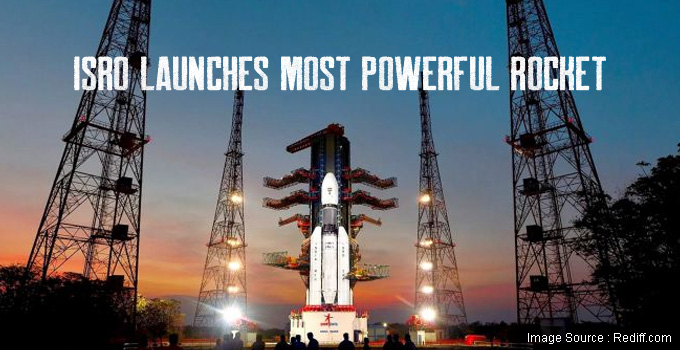It has been another success story for India and the ISRO with the successful launch of the heaviest-ever rocket Geosynchronous Satellite Launch Vehicle Mk III (GSLV-Mk III) on Monday, 5 June, 2017. Nicknamed as Bahubali, the 140 Ft satellite weighing 640-tonne lifted off at 5:28 pm from the south-eastern barrier island of Sriharikota off the coast of Andhra Pradesh and placed the advanced communication satellite Gsat-19 into orbit.
The scientists at Indian Space Research Organization are hopeful that in the near future the satellite will also carry astronauts into space, a feat that has been achieved so far by only Russia, China and the United States.
ISRO director, AS Kiran Kumar has said that the GSLV-Mk III is the heaviest rocket and satellite to be launched from India and is powered by an indigenous engine that uses liquid oxygen and liquid hydrogen as fuel.
A rocket that has been in the making since 2002 with the scientists relentlessly working on the project, it was indeed a historic day for the ISRO, stated Kumar. In the past, India has used French rockets to launch its heavier communication satellites.
Prime Minister Narendra Modi took to Twitter and congratulated the scientists of ISRO profusely. “The GSLV – MKIII D1/GSAT-19 mission takes India closer to the next generation launch vehicle and satellite capability. The nation is proud!,” Modi tweeted.
With the successful launch of the rocket, close at heels after India launched the Polar Satellite Launch Vehicle (PSLV) with a record breaking payload of 104 satellites in February this year, India hopes to further expand its interests in the commercial launch business, thus helping towards the economy of the country. The GSLV-Mk III will help build on the growing reputation of India in the $300 billion commercial satellite launching business.
GSLV-Mk III
India now joins the elite club of nations including US, European Space Agency, Russia, China and Japan with the development of the GSLV-Mk III with a desi engine that runs on cryogenic engine technology. The rocket has the following features:
- Nicknamed as Bahubali, the 140 Ft satellite weighs 640-tonne
- The new rocket will be able to transport heavier satellites
- Monday’s launch carried the nearly 7,000-pound GSAT-19 satellite, which has a 10-year life cycle and is meant to improve telecommunications and Internet services.
- GSLV Mk III launch has also proved the efficiency of CE20 indigenous cryogenic engine, a completely new technology designed to double the thrust and capability to lift double the payload than the previous GSLV Mk II, which could only carry a 2-tonne payload.
- The rocket costing ISRO Rs 300 crore, has also set the stage for India’s first manned mission.
The Future
India has increased the budget of its space program by more than 20 percent this fiscal year. The ISRO now has plans for a second mission to Mars and a possible Venus orbiter in cooperation with NASA.






